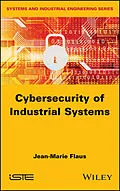How to manage the cybersecurity of industrial systems is a crucial question.
To implement relevant solutions, the industrial manager must have a clear understanding of IT systems, of communication networks and of control-command systems. They must also have some knowledge of the methods used by attackers, of the standards and regulations involved and of the available security solutions.
Cybersecurity of Industrial Systems presents these different subjects in order to give an in-depth overview and to help the reader manage the cybersecurity of their installation. The book addresses these issues for both classic SCADA architecture systems and Industrial Internet of Things (IIoT) systems.
Autorentext
Jean-Marie Flaus is Professor at the University of Grenoble, France, and teaches in several engineering schools. He is an expert on the cybersecurity of industrial systems and conducts research at the G-SCOP laboratory, in collaboration with INERIS and large companies.
Inhalt
Foreword xiii
Introduction xix
Chapter 1. Components of an Industrial Control System 1
1.1. Introduction 1
1.1.1. Definition: automated and cyber-physical systems 1
1.1.2. Definition: Information System (IS) 1
1.1.3. Definition: industrial IS or ICS 2
1.1.4. Definition: IT and OT system 4
1.1.5. Definition: SCADA 4
1.1.6. Definition: Distributed Control Systems (DCS) 5
1.1.7. Definition: Industrial Internet of Things (IIOT) 5
1.1.8. Different types of ICS 6
1.2. From the birth of the PLC to the SCADA system 6
1.3. Programmable logic controller (PLC) 8
1.4. RTU, master terminal unit and intelligent electronic device 12
1.5. Programmable Automation Controller 13
1.6. Industrial PC 13
1.7. Safety instrumented systems 13
1.8. Humanmachine interface (HMI) 15
1.9. Historians 17
1.10. Programming and parameter setting stations 17
1.11. Industrial Internet of Things (IIoT) 18
1.12. Network equipment 19
1.12.1. Switch and hub 19
1.12.2. Router and gateway 20
1.12.3. Firewall 20
1.12.4. IoT gateway 20
1.13. Data processing platform 21
1.14. Lifecycle of an ICS 22
Chapter 2. Architecture and Communication in an Industrial Control System 25
2.1. Network architecture 25
2.1.1. Purdue model and CIM model 26
2.1.2. Architecture of the Industrial Internet of Things 29
2.2. Different types of communication networks 31
2.2.1. Topology 31
2.2.2. Types of networks 33
2.2.3. Virtual private network 34
2.2.4. OSI model 34
2.3. Transport networks 35
2.3.1. Ethernet 35
2.3.2. Wi-Fi 36
2.3.3. The IEEE 802.15.1 (Bluetooth) standard 36
2.3.4. IEEE 802.15.4 networks 37
2.3.5. LPWAN networks 38
2.3.6. Cellular networks 38
2.4. Internet protocols 39
2.4.1. The Internet protocol 39
2.4.2. Transmission Control Protocol 39
2.4.3. Unified Datagram Protocol (UDP) 42
2.4.4. Address Resolution Protocol (ARP) 42
2.4.5. Internet Control Message Protocol (ICMP) 42
2.4.6. The IPv6 protocol 43
2.5. Industrial protocols 43
2.5.1. Introduction 43
2.5.2. Modbus 45
2.5.3. Profibus and Profinet 46
2.5.4. Actuator/sensor interface 47
2.5.5. Highway Addressable Remote Transducer 48
2.5.6. DNP3 and IEC 60870 48
2.5.7. The CAN bus 49
2.5.8. Ethernet/IP and Common Industrial Protocol (CIP) 49
2.5.9. OLE for Process Control (OPC) 51
2.5.10. Other protocols 52
2.6. IoT protocols 52
2.6.1. 6LowPAN 53
2.6.2. Message Queuing Telemetry Transport 53
2.6.3. CoAP 54
2.6.4. Other protocols 54
Chapter 3. IT Security 57
3.1. Security objectives 57
3.1.1. The AIC criteria 57
3.1.2. The different levels of IT security 61
3.2. Differences between IT and OT systems 64
3.2.1. The functionalities 64
3.2.2. The technology 65
3.2.3. System lifecycle 66
3.2.4. Security management 67
3.2.5. IT/OT convergence 68
3.2.6. Summary 68
3.3. Risk components 70
3.3.1. Asset and impact 70
3.3.2. Threats 71
3.3.3. Attacks 71
3.3.4. Vulnerabilities 72
3.3.5. Definition of risk 73
3.3.6. Scenarios and impact 74
3.3.7. Risk measurement 75
3.4. Risk analysis and treatment process 77
3.4.1. Principle 77
3.4.2. Acceptance of risk 79
3.4.3. Risk reduction 79
3.5. Principle of defense in depth 80
3.6. IT security management 82
3.7. Risk trea...
